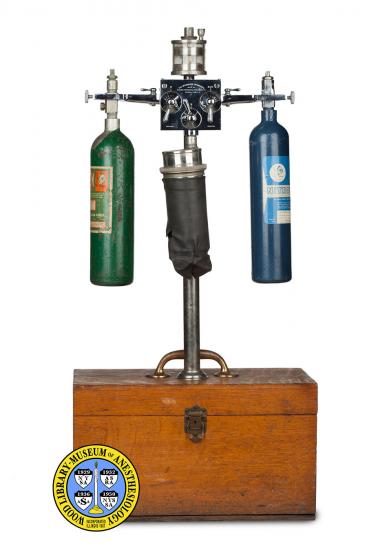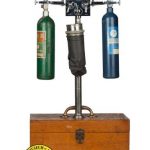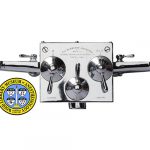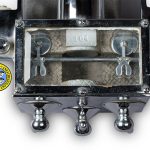McKesson Intermittent
Dr. Elmer I. McKesson (1881-1935) was internationally known as an expert in the use of nitrous oxide for anesthesia. He argued that it was a safer anesthetic than either chloroform or ether alone. He invented the McKesson Intermittent Flow Apparatus in 1910. In the same year, he also formed a company to manufacture it. This was the first anesthesia machine to have an automatic cut-off regulated by the patient's breathing. The air stream flowed only while the patient inhaled, and stopped when the patient exhaled, preventing waste. The machine could administer nitrous oxide, oxygen and ether, either singly or in combination. A small rubber rebreathing bag also allowed some of the patient's exhaled carbon dioxide to be reintroduced to the air stream. In his description of the machine, Dr. McKesson explained that the proportions of these vapors and gases should be continually adjusted in response to changes in the patient's condition. He urged that the patient's pulse, respiration and blood pressure should be recorded every five minutes. This monitoring function was incorporated into the later McKesson Nargraf Machine.
Catalog Record: McKesson Intermittent McKesson Intermittent
Access Key: akwl
Accession No.: 2012-01-31-1 and 2012-01-31-2
Title: The McKesson apparatus.
Author: McKesson, Elmer I. (Isaac), 1881-1935.
Corporate Author: Toledo Technical Appliance Co.
Title variation: Alt Title
Title: McKesson intermittent.
Publisher: Toledo, Ohio : Toledo Technical Appliances Company, [between 1911 and 1912].
Physical Description: 1 anesthesia machine : metals, wood, glass, rubber ; 125 x 48.5 x 25.5 cm.
Subject: Nitrous Oxide.
Subject: Oxygen.
Subject: Anesthesia Machines.
Subject: Anesthesia, Dental – instrumentation.
Web Link: http://woodlibrarymuseum.org/museum/item/751/mckesson-intermittent
Note Type: General
Notes: The date range for the possible year of manufacture are based on the date that the patent was applied for (Mary 1, 1911) and the date that the patent was granted (June 4, 1912). “PATENT PENDING” is marked on the front of the machine. The date range could change if documentation indicates the range should be corrected.
Note Type: General
Notes: The head of accession number 2012-01-31-2 was used for the photograph.
Note Type: Citation
Notes: McKesson EI, inventor. Anesthetic administering apparatus. US patent 1,028,582. June 4, 1912. http://www.google.com/patents/US1028582. Accessed August 29, 2014. [Application filed November 28, 1910.]
Note Type: Citation
Notes: McKesson EI. Nitrous oxid-oxygen anaesthesia: with a description of a new apparatus. Surg Gynecol Obstet. October, 1911;13(4):456-457. http://books.google.com/books?id=x_k1AQAAMAAJ&printsec=frontcover#v=onepage&q&f=false. Accessed August 29, 2014.
Note Type: Physical Description
Notes: One early nitrous oxide-oxygen anesthesia machine that disassembles into a wooden carrying case; The rectangular head of the machine is supported on a pole that is screwed into a threaded hole in the lid of a wooden case; Three levered control dials are located on the front of the head of the machine; A line and the letter “O” (for oxygen) are marked above the dial on the upper left of the front of the head of the machine; The dial is marked in increments of 5 from 0 to 100; The increments at 0, 25, 50, 75, and 100 are numbered; A line and “N2O” is marked above the dial on the upper right; It is marked with the same increments and numbers as the dial for oxygen; A line and the letter “R” are marked above the dial on the lower center; One area of the dial it is marked with, “OFF,” and on another area it is marked with “ON”; Manufacturer markings on the front of the head include, “THE McKesson APPARATUS [new line] Mfr’d by [new line] TOLEDO TECHNICAL APPLIANCE CO. [new line] TOLEDO, OHIO”; “PATENT” and “PENDING” are also marked on the front of the head; The top of the head is clear glass; The number :104″ is stamped inside the head of the apparatus; On the bottom of the head is an opening with a screw clamp to accept and secure the head to the top of a stand; At the back of the head, is an opening for an electric bulb for warming anesthetic in the vaporizer above; A round opening in the top of the extension for the heater is threaded for the bottom of the vaporizer to twist in place; The vaporizer is glass and metal; A valve to select between the two openings for the nasal inhaler tubing or face mask tubing sits on top of the vaporizer; On either side of the head are two arms with two yokes each; The width is approximately 40.5 cm; The head is approximately 19 cm in depth; A control valve with a turn lever is located on each arm where the extensions for the two yokes meet; There are three connections for breathing bags; The central bag, or “adjustable re-breathing bag,” is composed of a cylindrical canister that has holes in the bottom. The canister is surrounded by a rubber rebreathing bag; The bag is ripped at the end; Measured as one unit, the bag and the canister measure approximately 25.5 cm in height and 9 cm in diameter; “100” is the only marking on the canister; The lid of the wooden case is hinged and has a single latch in the front; The lid is topped with a sturdy handle; The bottom of the box has water damage and some erosion; The case and handle, with the apparatus disassembled, measure approximately 32.5 x 48.5 x 25.5 cm.
Note Type: Reproduction
Notes: Photographed by Mr. Steve Donisch, September 17, 2013, with the ‘head unit of accession number 2012-01-31-2″.
Note Type: Historical
Notes: Dr. Elmer I. McKesson (1881-1935) was internationally known as an expert in the use of nitrous oxide for anesthesia. He argued that it was a safer anesthetic than either chloroform or ether alone. He invented the McKesson Intermittent Flow Apparatus in 1910. In the same year, he also formed a company to manufacture it. This was the first anesthesia machine to have an automatic cut-off regulated by the patient’s breathing. The air stream flowed only while the patient inhaled, and stopped when the patient exhaled, preventing waste. The machine could administer nitrous oxide, oxygen and ether, either singly or in combination. A small rubber rebreathing bag also allowed some of the patient’s exhaled carbon dioxide to be reintroduced to the air stream. In his description of the machine, Dr. McKesson explained that the proportions of these vapors and gases should be continually adjusted in response to changes in the patient’s condition. He urged that the patient’s pulse, respiration and blood pressure should be recorded every five minutes. This monitoring function was incorporated into the later McKesson Nargraf Machine.
Note Type: Exhibition
Notes: Selected from the WLM website.




